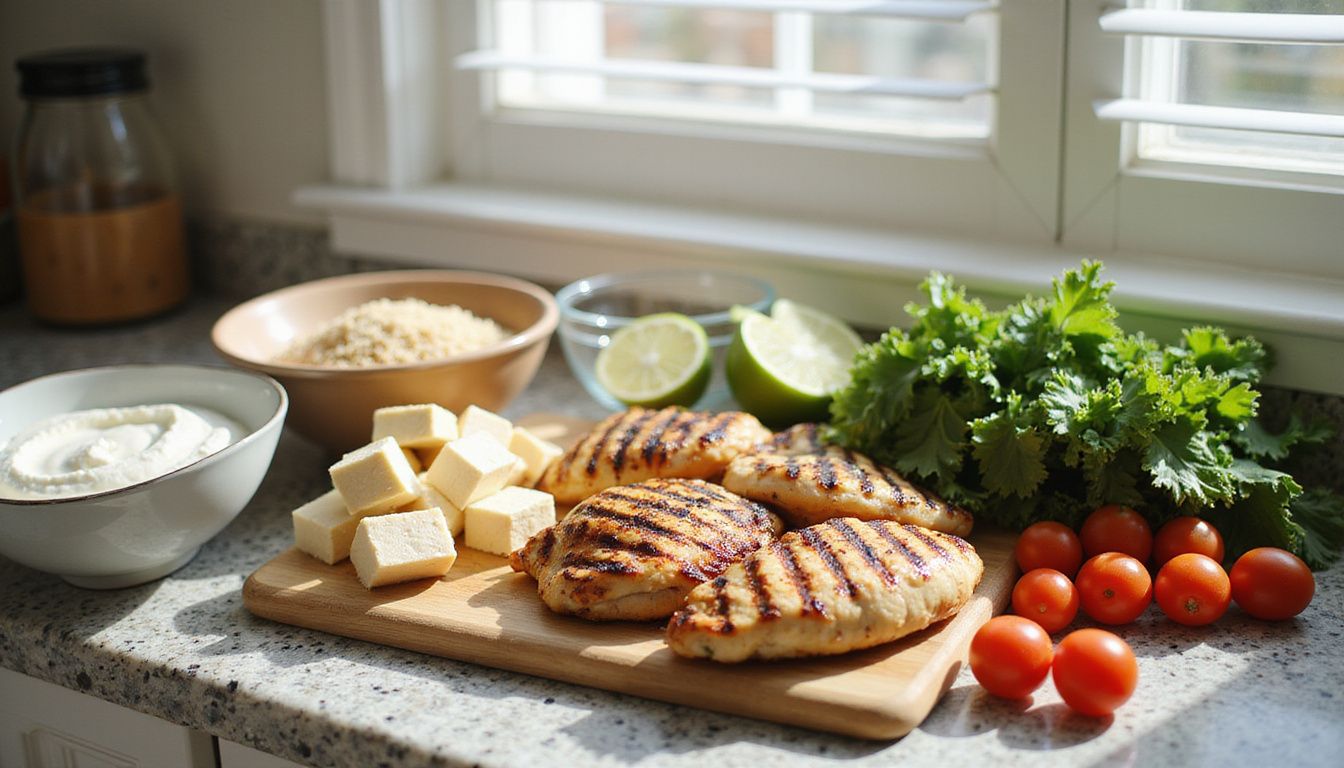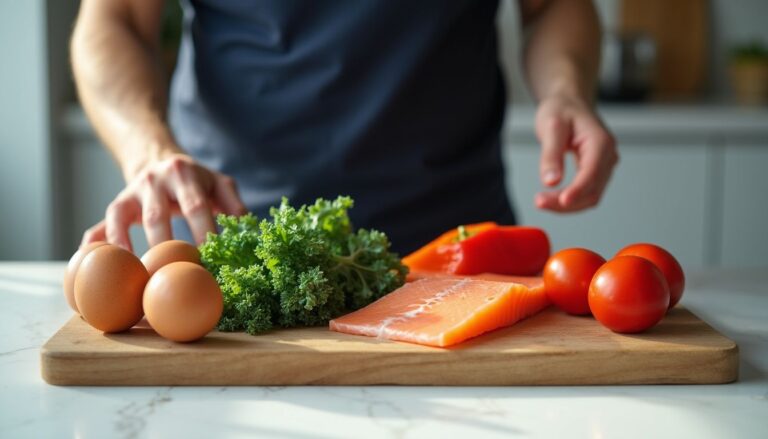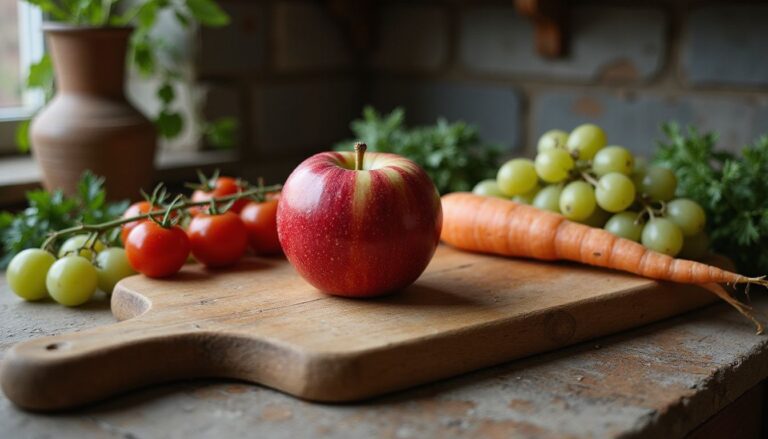Delicious High Protein Low Fat Foods For A Healthy Diet
Our Nutrition Assistant AI Suite will transform your body. You will lose fat, get toned, and build muscle. Gain confidence and optimal health.
Finding meals that keep you full without extra fat and calories can feel tricky. High-protein, low-fat foods like lean chicken breast and nonfat Greek yogurt give you steady energy and support heart health. They also help reduce the risk of heart disease.
This guide shares clear facts, simple tips, and easy recipes to help you add more protein food choices to daily meals. You will see how healthy eating can be both satisfying and simple.
Key Takeaways
- High-protein, low-fat picks such as skinless chicken breast, nonfat Greek yogurt, and lentils help build muscle while limiting calories and saturated fat.
- Federal guidance suggests protein should be 10 to 35 percent of daily calories, and adults need about 0.8 grams per kilogram of body weight each day.
- Lean options from both plants and animals, including turkey breast, cottage cheese, tuna in water, tofu, edamame, quinoa, cod, shrimp, and scallops, deliver quality protein with little saturated fat.
- These foods can support weight control, improve fullness, and may help lower LDL cholesterol linked to heart disease risk, consistent with USDA recommendations.
- Portable choices like hard-boiled egg whites, almonds, low-fat string cheese, and low sodium jerky make it easy to boost daily protein while limiting unhealthy fats.

Why Are High Protein, Low Fat Foods Important for Your Health?

High-protein, low-fat foods play a central role in a healthy diet. Protein supplies amino acids, the building blocks your body uses for muscle growth, tissue repair, blood clotting, and immune function. Nine amino acids are called essential because you must get them from food.
Choosing protein that is low in saturated fat helps you feel full longer and supports weight control. Federal guidelines recommend 10 to 35 percent of daily calories from protein. The RDA is about 0.8 grams per kilogram of body weight per day.
For example, a person weighing 165 pounds, or 75 kilograms, needs about 60 grams of protein per day.
Lean choices such as skinless chicken breast, tofu, lentils, and seafood offer benefits beyond meeting daily protein needs. A diet rich in quality protein may support healthy cholesterol, bone strength, and exercise recovery. Keeping saturated fat lower supports heart health and helps reduce LDL cholesterol linked to cardiovascular disease and obesity risk. I noticed better workout energy and steadier blood sugar after swapping some red meat for grilled fish in my weekly meals.
(For more details see U.S. Department of Agriculture dietary recommendations, 2024.)
Animal-Based High Protein, Low Fat Food Options
Animal proteins like chicken, turkey, and fish are rich in protein and lower in fat compared with fattier cuts of meat. These foods can help you build muscle and support weight loss goals.
What Are the Benefits of Skinless Chicken Breast?
Skinless chicken breast is a lean, convenient protein source. A 174 gram portion provides about 55.9 grams of protein with only 5.64 grams of fat. A 3 ounce serving contains roughly 26 grams of complete protein, which supports muscle repair with fewer calories.
Removing the skin cuts saturated fat compared with thighs or wings. That supports heart health and fits the pattern seen in the Mediterranean style of eating. Many clinicians suggest chicken breast for people managing cholesterol or weight. It helps you stay full longer, which makes calorie control easier.
In short, chicken breast delivers plenty of protein, fewer calories than fatty meats, and very little saturated fat. It is one of the best high-protein foods for a healthy diet.
Why Choose Lean Turkey for Protein?
Lean turkey breast supplies a lot of protein with very little fat. In 100 grams of cooked, skinless turkey breast, you get about 30.1 grams of protein and only 2.08 grams of fat. Saturated fat is lower than many cuts of beef or pork, which makes it a strong choice for a low-fat plan.
Turkey keeps you full, supports muscle building, and adds key minerals like iron and zinc for immune support. A 3 ounce portion offers plenty of protein for a meal or snack.
I switched to ground lean turkey last year when I wanted more protein but less fat in my daily meals; it made meal prep easier while helping me reach my nutrition goals.
Lean turkey works in tacos, salads, and soups. If you want more protein without extra fat, egg whites are another helpful choice.
How Can Egg Whites Boost Your Protein Intake?
Egg whites are a high-quality, low-fat protein with almost no cholesterol. One large egg has about 6.24 grams of protein and 5.01 grams of fat. The white alone provides around 3.5 grams of protein with nearly zero fat.
Eggs are a complete protein, so you get all nine essential amino acids. That makes egg whites useful for muscle repair. Enjoy them hard-boiled as a portable snack, or add whites to omelets, salads, and sandwiches to raise protein without many calories.
Many athletes and people watching cholesterol use egg whites to meet daily protein needs while keeping fat lower.
What Makes Low-Fat Cottage Cheese a Healthy Choice?
Low-fat cottage cheese is rich in protein and lighter in saturated fat than many other dairy foods. One cup, about 220 grams, supplies about 24.2 grams of protein and only 5 grams of fat. Half a cup still gives you about 12.4 grams of protein.
It also provides calcium for bone health. You can add it to snacks, salads, or breakfast bowls for a quick boost of protein with limited calories. It stores well, which helps with weekly meal prep.
How Does Nonfat Greek Yogurt Fit into a Low Fat Diet?
Nonfat Greek yogurt offers a strong protein punch with very little fat. A 156 gram serving delivers about 16.1 grams of protein and just 0.577 grams of fat. A 4 ounce portion has around 6 grams of protein.
It helps you feel full, supports bone health with calcium, and provides probiotics that aid digestion. Use it as a base for breakfast, in smoothies, or as a swap for sour cream. Mixing nonfat Greek yogurt with fruit makes a fast, satisfying meal.
If you like seafood, white fish can deliver even more protein with very little fat.
Which White Fish Are Best for High Protein and Low Fat?
White fish are lean, versatile, and provide essential minerals. They fit well into a balanced, heart-friendly plan.
- Whiting has about 20.5 grams of protein and 5.54 grams of fat in a 90 gram baked fillet, based on USDA data.
- Cod offers about 18 grams of protein per 100 grams with less than 1 gram of fat.
- Tilapia contains around 20 grams of protein per 100 grams and less than 2 grams of fat.
- Haddock provides about 17 grams of protein per 100 grams and is very low in total fat.
- Pollock delivers nearly 18 grams of protein and about 0.9 grams of fat per 100 grams.
- Flounder supplies roughly 18 grams of protein with just under 2 grams of fat per serving.
- Halibut gives about 22 to 23 grams of protein per 100 grams cooked, with under 2.6 grams of fat.
These fish support heart health and fit well with Mediterranean style eating, a pattern also encouraged by groups such as the NHS. Next, review plant-based choices that deliver high protein with low fat.
Is Tuna in Water a Good Protein Source?
Tuna packed in water is an easy, lean protein. One can, about 172 grams, provides about 40.6 grams of protein and only 5.11 grams of fat. You also get selenium, an antioxidant mineral that protects cells.
Canned tuna stores well and is simple to use in salads, sandwiches, and meal prep. Regular use may help improve cholesterol patterns as part of a balanced plan. It is a reliable way to raise daily protein without adding much fat.
Plant-Based High Protein, Low Fat Food Choices
Plant-based foods like beans and legumes offer protein with little fat plus fiber and key vitamins. They work well for plant-based diets and for anyone who wants more dietary fiber while keeping fat lower.
How Do Lentils Provide Protein with Low Fat?
Lentils deliver a lot of protein with very little fat. In 100 grams of dry lentils, there are about 23.6 grams of protein and 1.92 grams of fat. A half cup of cooked lentils has around 9 grams of protein, which makes them a strong choice for plant-based protein.
Lentils also supply fiber and minerals that support digestion and heart health. They are affordable, shelf-stable, and easy to add to soups, salads, and stews. I often include cooked lentils in meal prep because they keep me full and help with weight management.
| Nutrient | Amount per 100 g | Notes |
|---|---|---|
| Protein | 23.6 g | High-quality plant protein |
| Fat | 1.92 g | Low in saturated fat |
| Dietary Fiber | High | Supports gut health |
| Calories | Low | Helpful for weight control |
Lentils are a smart choice for balanced meals that are rich in protein and fiber.
What Are Easy Ways to Add Chickpeas to Meals?
Chickpeas make it simple to add plant protein and fiber to your meals. They are tasty, flexible, and budget friendly.
- Stir chickpeas into salads for extra protein and texture. A 100 gram portion has about 20.5 grams of protein and only 6.04 grams of fat.
- Add them to soups and stews with vegetables and whole grains.
- Build grain bowls with quinoa, roasted chickpeas, and steamed vegetables.
- Roast chickpeas with spices for a crunchy, high-protein snack.
- Blend chickpeas into hummus with tahini, lemon, and garlic.
- Use chickpea flour to raise protein in savory pancakes or pasta dough.
- Toss chickpeas into curries or stir-fries with tofu, tempeh, or edamame.
- Mash chickpeas for burger patties or falafel to boost protein and fiber.
Edamame is another easy plant-based protein that adds variety to meals.
Why Should You Include Edamame in Your Diet?
Edamame, or young soybeans, is a complete plant protein. Every 100 grams gives about 11.2 grams of protein and 4.73 grams of fat. Complete protein means it includes all nine essential amino acids your body needs.
Edamame offers protein and fiber together, which improves fullness and supports digestion. Steam in the pod for a simple snack or add shelled edamame to stir-fries and salads. It is also gluten free, so it suits many diets.
How Can Tempeh Be Used in Healthy Cooking?
Tempeh is a fermented soy product that provides complete protein. A 100 gram serving contains about 19 grams of protein with only 5 grams of fat. Fermentation may support gut health and improve mineral absorption.
Marinate sliced tempeh, then grill, bake, or stir-fry it for a quick main dish. Use it in tacos, crumble it into chili, or add cubes to soups. Its mild flavor soaks up spices and herbs, which helps you keep sauces and oils light.
After trying tempeh, add tofu to your rotation for even more plant-based protein options.
What Are Simple Ways to Cook with Tofu?
Tofu is a complete protein that fits many healthy diets. Firm tofu has about 10.9 grams of protein and only 4.19 grams of fat per 100 grams.
- Grill tofu on a nonstick pan for a smoky, protein-rich main.
- Bake firm tofu cubes at 400°F for 20 minutes for a crispy topping.
- Stir-fry with colorful vegetables and minimal oil to limit saturated fat.
- Simmer tofu in soups so it absorbs broth flavor and adds protein.
- Marinate with soy sauce, garlic, or herbs for at least 1 hour.
- Scramble pressed tofu with turmeric and black beans for breakfast.
- Freeze tofu before cooking to create a chewier, meat-like texture.
Quinoa pairs well with tofu and adds a different kind of plant-based protein.
Why Is Quinoa a Good Plant-Based Protein?
Quinoa is a seed that cooks like a grain and counts as a complete protein. One cooked cup provides about 8.14 grams of protein, 3.55 grams of fat, and around 5 grams of fiber. It is naturally gluten free.
Quinoa helps support fullness and muscle repair. Use it as a base for bowls or salads, or as a swap for refined pasta. It cooks quickly and stores well, which makes weekly planning easier.
How Do Black Beans Support a High Protein Diet?
Black beans are a budget-friendly way to raise protein and fiber. In every 100 grams of canned black beans, there are about 6.91 grams of protein and 1.27 grams of fat.
Their fiber supports steady energy and heart health. Add black beans to salads, soups, and burritos. They fit well in vegetarian and vegan diets. Batch cooking black beans can save money and time during the week.
Seafood High in Protein and Low in Fat
Seafood offers lean protein and important omega-3 fatty acids, which support heart and brain health. Shrimp, salmon, and white fish are easy places to start.
How Should You Prepare Shrimp for a Healthy Meal?
Shrimp is a lean protein that cooks fast and tastes great. An 85 gram serving offers about 17.1 grams of protein with only 0.433 grams of fat.
- Choose fresh or frozen wild-caught shrimp if available.
- Peel and devein before cooking.
- Boil, grill, or steam instead of frying to keep fat low.
- Season with herbs, spices, or lemon instead of butter sauces.
- Serve with salads, whole grain pasta, or quinoa for a balanced plate.
- Use a small drizzle of olive oil if needed for cooking.
- Keep portions near 85 grams to control calories and support muscle health.
What Are the Omega-3 Benefits of Including Salmon?
Wild-caught salmon provides protein and omega-3 fatty acids that help lower the risk of cardiovascular disease. An 85 gram portion gives about 21.6 grams of protein and 6.91 grams of fat. Omega-3s may reduce inflammation and support brain and heart function.
Salmon also contains vitamin D and selenium, which support bones and the immune system. Grill, bake, or broil salmon to keep fat lower while preserving flavor.
How Can Scallops Be Cooked Healthily?
Scallops are lean, quick to cook, and naturally sweet. Preparing them with light methods keeps calories in check.
- Sear in a nonstick pan with olive oil spray for a golden crust.
- Grill on skewers with lemon and herbs to keep fat low.
- Bake at 400°F for 10 minutes on parchment to avoid extra oil.
- Add to salads or whole grain pasta to raise protein without heavy sauces.
- Avoid breaded or fried versions to limit fat and cholesterol.
- Use scallops as a lean option for families aiming to keep saturated fat lower.
- Stir-fry with vegetables and a splash of low-sodium soy sauce for a fast meal.
- Using fresh scallops and simple seasonings preserves texture and taste.
- If buying frozen, check the label for added sodium or preservatives.
Why Choose Crab for High Protein, Low Fat Eating?
Crab is a lean seafood with strong protein per serving. A 3 ounce portion provides about 17 grams of protein and roughly 1 gram of fat. It is also a source of zinc and selenium, minerals that support immune health.
Steaming or boiling keeps calories lower and avoids extra saturated fat. Many people use crab as a lighter swap for red meat in salads and simple dinners. It fits both pescatarian and general healthy eating patterns.
Convenient High Protein, Low Fat Snacks and Portable Options
Smart snacks help you meet daily protein goals and control hunger between meals. These options are easy to carry and quick to eat.
How to Prepare and Pack Hard-Boiled Egg Whites?
Hard-boiled egg whites are a fast, low-fat snack. Each white offers about 3.5 grams of high-quality protein with almost no fat or cholesterol.
- Boil eggs for 9 to 12 minutes, then chill in ice water for easy peeling.
- Peel under cold water, slice, and remove the yolks.
- Pack whites in small containers for grab-and-go snacking.
- Season with herbs or pepper, or add chopped veggies for flavor.
- Refrigerate up to three days, or keep up to four hours without chilling.
- Use egg whites to support muscle repair and fullness with minimal calories.
- Choose them instead of snacks that are high in saturated fat.
- Pair with whole grain cereal or nonfat Greek yogurt for a quick mini-meal.
Is It Healthy to Snack on Almonds in Moderation?
Almonds provide about 6 grams of protein per ounce along with healthy fats that support heart health. They also supply vitamin E, magnesium, and fiber, which can improve cholesterol patterns and digestion.
Portion control matters because nuts are calorie dense. Add a small handful to yogurt or trail mix for a filling snack. I keep single-serve bags in my backpack for busy days. One handful tides me over after school or work.
What Are the Benefits of Low-Fat String Cheese?
Low-fat string cheese is portable and packs around 7 grams of protein per stick with limited saturated fat. It supplies high-quality dairy protein and calcium for bones and teeth.
String cheese travels well for lunches, office snacks, or the gym bag. Pair with fruit or whole-grain crackers for a balanced bite. Choosing a low-fat version helps you manage calories while staying satisfied between meals.
How to Select Low Sodium Jerky for Snacking?
Low sodium jerky can be a smart, high-protein snack if you read labels carefully. Look for simple ingredients and modest salt levels.
- Pick jerky with 140 milligrams of sodium or less per serving.
- Choose lean sources, like beef round, turkey breast, or plant-based options such as seitan or pea protein.
- Aim for at least 10 grams of protein per ounce.
- Avoid products with added sugars and many preservatives.
- Pick simpler flavors to keep sugar and salt lower.
- Seek “low sodium” or “no added salt” on the label.
- Watch serving size to manage calories.
- Use shelf-stable packs for travel or long days.
- Try different protein sources to add variety.
- Check reviews and certifications for quality and safety.
- Reach for jerky instead of chips or candy to increase protein and nutrients.
What Should You Look for in Low Sugar Protein Bars?
Scan labels for bars with less than 5 grams of added sugar per serving. Choose at least 15 to 20 grams of protein, from whey protein powder or plant-based protein, based on your needs.
Keep saturated fat and sodium on the lower side. Favor bars with whole food ingredients like nuts, seeds, or strained yogurt. Aim for at least 3 grams of fiber for better fullness and steadier blood sugar. Higher protein and fiber bars help on long days without energy crashes.
What Are the Health Benefits of High Protein, Low Fat Foods?
Protein is an essential building block for cells and tissues, so getting enough supports strength, healing, and immune function. Many high-protein, low-fat foods also provide B vitamins and minerals that aid energy and metabolism.
How Do These Foods Support Muscle Growth and Repair?
Eating protein-rich meals improves muscle growth and recovery. Chicken, egg whites, and low-fat cottage cheese give you complete proteins that contain all essential amino acids. Plant foods, like lentils and navy beans, add more protein and fiber for balance.
Adults over 50 may benefit from at least 1 gram of protein per kilogram of body weight to help maintain muscle mass. After exercise, protein from either animal or plant sources speeds recovery. Greek yogurt, lean turkey, or tofu are strong choices if you want to lose weight without losing strength.
Can They Help with Weight Management?
Yes. Higher protein intake raises fullness, which can lower calorie intake across the day. Swapping fatty meats for lean cuts, like loin or skinless poultry, can reduce calories while keeping meals satisfying.
Seafood rich in omega-3 fatty acids supports heart health and helps you feel full. Beans and lentils add fiber, which steadies blood sugar and curbs cravings. In my meal prep, hard-boiled egg whites and low-fat string cheese helped me avoid mid-morning snacks that were less healthy.
Research published in 2021 found that people on higher-protein diets lost more weight and were less likely to regain it than those on lower-protein diets. Consistent intake makes long-term weight control easier.
Do High Protein, Low Fat Foods Increase Metabolism?
Protein has a higher thermic effect than carbs or fats. Your body uses more energy digesting it. Raising protein to around 25 to 30 percent of daily calories can increase calorie burn by about 80 to 100 calories per day.
Protein also helps you keep lean muscle, which burns more calories at rest. Combining lean protein with resistance training improves these effects. Many people notice better satiety and steady energy when they add egg whites or Greek yogurt to breakfast after workouts.
How Do They Help You Feel Full Longer?
High-protein foods slow stomach emptying and trigger fullness hormones. Nonfat Greek yogurt and low-fat cottage cheese are great examples. That means fewer cravings and fewer extra calories across the day.
Options like egg whites, kidney beans, peas, and lean turkey provide lasting energy. Beans and lentils add fiber, which extends fullness even more. Regular use of these foods can help you stick to your calorie goals.
What Overall Health Improvements Can You Expect?
You may see improved cholesterol patterns, including lower LDL levels, when you choose lean proteins more often. Diets with more plant protein are linked to lower risk of dementia compared with diets higher in refined carbohydrates.
Eating different protein sources gives you vitamins and minerals such as iron, calcium, and zinc. These support immune function, bone health, and healthy skin. Getting enough dietary protein also supports wound healing.
If you have a medical condition or special diet needs, talk with your healthcare professional or a registered dietitian for personalized advice.
How Can You Add High Protein, Low Fat Foods to Your Meals?
Raising protein is easier when you plan a few swaps. Try skinless chicken breast or tofu in place of higher-fat meats. Add cottage cheese, egg whites, or black beans to bowls, wraps, and salads.
What Are Tips for Planning Balanced Meals?
Include a protein source at each meal, such as skinless chicken breast, lentils, tofu, or low-fat cottage cheese. Aim for 10 to 35 percent of calories from protein and pair it with vegetables, fruit, and whole grains for fiber and steady energy.
Pick lean meats and fish to limit saturated fat. Add beans and legumes for minerals and plant nutrients. Nuts and peanut butter are nutritious but calorie dense, so keep portions measured.
Prepping meals ahead makes balanced plates more likely and helps you avoid last-minute choices that are higher in fat or sugar.
How to Use Herbs and Spices Instead of Sauces?
Fresh herbs like basil, cilantro, and parsley add bright flavor with no extra fat. Sprinkle them on grilled chicken, plain Greek yogurt, or white fish. Spices such as cumin, paprika, and turmeric bring warmth and depth with very few calories.
People often season cottage cheese with herbs and spices for a tasty, high-protein snack. Try cumin and paprika with lentils, or chives and dill on egg whites. Flavorful meals make healthy eating easier to maintain.
Why Should You Diversify Your Protein Sources?
Mixing protein sources improves nutrition and keeps meals interesting. Animal proteins offer all essential amino acids. Plant proteins, like lentils, chickpeas, and quinoa, add fiber and minerals that many people lack.
Combining different sources helps you meet macronutrient goals and supports complete amino acid coverage. For example, add edamame to salads or use tofu in stir-fries. Pair white fish with nut toppings, or combine black beans with low-fat cottage cheese for variety.
How Does Preparing Meals Ahead Help Your Diet?
Meal prep gives you control over portions, ingredients, and calories. Measuring before storage lowers the risk of overeating. It also reduces reliance on last-minute takeout, which is often higher in saturated fat or sugar.
Prepping several chicken and quinoa bowls on Sunday can keep you on track during a busy week. You will also cover your mineral and vitamin needs more consistently, without depending on dietary supplements at the last minute. People who plan meals are less likely to consume empty calories during the week^1^.
^1: Harvard T.H. Chan School of Public Health (2022). “Meal Planning.”.
Delicious Recipes Featuring High Protein, Low Fat Ingredients
These simple recipes make it easy to enjoy high-protein, low-fat meals. Each dish highlights protein and essential minerals while fitting into a healthy eating plan.
How to Grill a Healthy Chicken Salad?
Grilled chicken salad delivers protein, vitamins, and fiber with limited saturated fat. Follow these steps for a balanced bowl.
- Choose skinless chicken breast. A 3 ounce serving offers about 26 grams of protein.
- Grill instead of frying to limit added fat, brushing lightly with olive oil if needed.
- Add vegetables like spinach, tomatoes, and cucumbers for fiber and color.
- Top with low-fat cottage cheese or nonfat Greek yogurt for extra protein.
- Include cooked quinoa for additional protein and minerals like iron.
- Dress with olive oil, lemon juice, and fresh herbs instead of heavy sauces.
- Combine animal and plant proteins for a complete amino acid profile.
- Serve right away or chill for later. Proper storage keeps textures fresh.
What’s a Simple Lentil and Vegetable Soup Recipe?
This lentil soup is hearty, low in fat, and rich in fiber. It is perfect for batch cooking.
- Rinse 1/2 cup lentils and add to a medium pot.
- Pour in 4 cups low-sodium vegetable broth.
- Chop 1 carrot, 1 celery stalk, and 1 small onion, then add to the pot.
- Stir in a can of diced tomatoes for flavor and vitamin C.
- Season with garlic powder, black pepper, thyme, or parsley.
- Simmer on medium until lentils are tender, about 25 minutes.
- A half cup of cooked lentils provides roughly 9 grams of protein with little fat.
- Store leftovers in meal prep containers for quick lunches.
- Swap or add vegetables like spinach, zucchini, or red bell pepper.
- Enjoy as a protein-forward lunch or as a side with grilled fish or chicken.
How to Stir-Fry Tofu with Vegetables?
This quick stir-fry delivers protein and color in under 20 minutes.
- Cut firm tofu into cubes and press for 10 minutes to remove excess water.
- Heat 1 to 2 teaspoons olive oil in a nonstick pan over medium-high heat.
- Cook tofu for 3 to 4 minutes per side until golden.
- Add bell peppers, broccoli, and carrots. Stir-fry 3 to 5 minutes until crisp-tender.
- Season with black pepper, garlic powder, or curry powder instead of heavy sauces.
- Combine tofu and vegetables, then toss gently.
- Serve over brown rice, or mix with chickpeas or quinoa to raise protein even more.
Ready for a fast seafood option? Try these simple shrimp tacos.
How to Assemble Shrimp Tacos with Whole Grain Tortillas?
These tacos are high in protein and quick to cook. Whole grain tortillas add fiber for fullness.
- Use 3 ounces, or 85 grams, of raw shrimp per serving.
- Grill or sauté with chili powder, garlic powder, and lime juice.
- Warm whole grain tortillas.
- Layer lettuce and tomatoes for crunch and vitamins A and C.
- Add nonfat Greek yogurt for a creamy, high-protein topping.
- Place shrimp on the tortillas and add your vegetables and yogurt.
- Top with salsa and fresh cilantro. Add avocado slices if you want healthy fats.
Explore more recipes like grilled chicken salad or lentil soup to keep variety high and saturated fat lower.
Conclusion
High-protein, low-fat foods make it easier to build muscle, support metabolism, and stay full. Options like chicken breast, Greek yogurt, lentils, tofu, and seafood keep meals satisfying without extra saturated fat. Small swaps can raise protein at each meal and snack.
Choose a mix of animal, plant, and seafood proteins for balance. If you have medical concerns such as diabetes or kidney disease, speak with a healthcare professional or registered dietitian for personal guidance. With steady practice and simple planning, your plate can support lasting energy and long-term health.
FAQs
1. What are some examples of delicious high protein low fat foods for a healthy diet?
Lean poultry, white-fleshed fish, cottage cheese, Greek yogurt, and egg whites are excellent choices. These foods offer high protein with minimal fat, making them suitable for balanced meals.
2. How much protein do these foods provide compared to their fat content?
For example, three ounces of chicken breast contain about 26 grams of protein and less than 3 grams of fat. One cup of nonfat Greek yogurt provides around 20 grams of protein and zero fat. These ratios help support muscle health while limiting calorie intake from fat.
3. Why should I include high protein low fat foods in my diet?
Research shows that diets rich in lean proteins can aid weight management, preserve muscle mass during weight loss, and support metabolic health (Harvard T.H. Chan School of Public Health). Personal experience confirms that adding more fish and dairy to meals can increase satiety and energy levels throughout the day.
4. Can high protein low fat foods fit into different meal plans or eating styles?
Yes, these foods are versatile for many dietary needs including vegetarian, Mediterranean, or heart-healthy plans. For instance, cottage cheese pairs well with fruit for breakfast; grilled fish works as a main dish at dinner. This flexibility makes it easier to maintain healthy habits over time.
Summary: High protein low fat foods such as poultry, fish, dairy products, and egg whites provide essential nutrients without excess calories from fat. They support weight control, muscle maintenance, and overall well-being when included regularly in meals.







